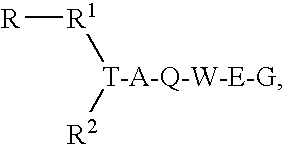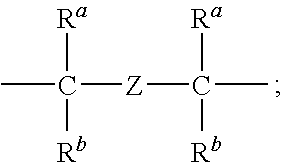Renin Inhibitors
a renin inhibitor and renin technology, applied in the field of renin inhibitors, can solve the problems of insufficient soluble renin inhibitors that can be prepared on a large scale, high cost of goods, and the inability to develop several compounds orally, and achieves low molecular weight, high in vitro activity, and high cost of goods.
- Summary
- Abstract
- Description
- Claims
- Application Information
AI Technical Summary
Benefits of technology
Problems solved by technology
Method used
Image
Examples
preparation b
[0298]
Step 1. 5-hydroxy-N-methoxy-N-methylpentanamide
[0299]To a stirred suspension of N,O-dimethylhydroxylamine hydrochloride (14.6 g, 150 mmol) in dry dichloromethane (150 mL) was added trimethylaluminum (2.0 M in toluene, 75 mL, 150 mmol) drop wise at room temperature. After stirring for 30 mins, tetrahydropyran-2-one (10 g, 100 mmol) in dichloromethane (50 mL) was added drop wise. The reaction mixture was stirred over night at room temperature. At 0° C., 1 N HCl (80 mL) was added slowly (exothermic reaction) then the reaction mixture was extracted with dichloromethane (3×200 mL). The combined organic phases were dried over sodium sulfate, filtered and concentrated. The residue was purified by column chromatography on silica gel (120 g column, dichloromethane to 20% methanol in dichloromethane) to give product (9.7 g, 60%).
[0300]1H NMR (CDCl3) δ 3.68 (s, 3H), 3.63 (t, J=6.1 Hz, 2H), 3.17 (s, 3H), 2.46 (t, J=7.0 Hz, 2H), 1.69-1.74 (m, 2H), 1.58-1.64 (m, 2H); MS EI m / z 162.21 (M+H)+...
preparation d
[0313]
Step 1. 1,1-dimethylethyl (2-{(6-chloro-3′-ethyl-2-biphenylyl)[4-(methyl oxy)butyl]amino}ethyl)methylcarbamate
[0314]A solution of (6-chloro-3′-ethyl-2-biphenylyl)[4-(methyloxy)butyl]amine (0.2 g, 0.63 mmol) and 1,1-dimethylethyl methyl(2-oxoethyl)carbamate (0.33 g, 1.89 mmol) in CHCl3 at 65° C. was treated with acetic acid (0.04 mL, 0.63 mmol) followed by sodium triacetoxyborohydride (0.53 g, 2.52 mmol) added in portions. The reaction mixture was stirred at 65° C. overnight before being quenched with the addition of 6 mL of aqueous 2N NaOH and extracted with CH2Cl2 (2×15 mL). The combined organic extracts were dried (MgSO4), concentrated under reduced pressure, and subjected to flash chromatography to provide 1,1-dimethylethyl (2-{(6-chloro-3′-ethyl-2-biphenylyl)[4-(methyloxy)butyl]amino}ethyl)methylcarbamate as a colorless oil (0.26 g, 87%).
Step 2. (6-chloro-3′-ethyl-2-biphenylyl)[2-(methylamino)ethyl][4-(methyloxy)butyl]amine
[0315]A solution of 1,1-dimethylethyl (2-{(6-chlor...
example 1
(1S,3R,4S)-3-amino-N-[3-(6-chloro-3′-methyl-2-biphenylyl)-3-hydroxy-7-(methyloxy)heptyl]-4-hydroxy-N-methylcyclopentanecarboxamide (Compd No. 1)
[0316]
Step 1. 1,1-dimethylethyl ((1R,2S,45)-4-{[[3-(6-chloro-3′-methyl-2-biphenylyl)-3-hydroxy-7-(methyloxy)heptyl](methyl)amino]carbonyl}-2-hydroxycyclopentyl)carbamate
[0317]A solution of 3-(6-chloro-3′-methyl-2-biphenylyl)-1-(methylamino)-7-(methyloxy)-3-heptanol (50 mg, 0.12 mmol) in 0.5 mL of DMF at 25° C. was treated with (1S,3R,4S)-3-({[(1,1-dimethylethyl)oxy]carbonyl}amino)-4-hydroxycyclopentanecarboxylic acid (29 mg, 0.12 mmol), i-Pr2NEt (0.098 mL, 0.6 mmol), HBTU (45 mg, 0.12 mmol), and HOBt (16 mg, 0.12 mmol) and stirred overnight. The mixture was poured into water and extracted with EtOAc. The combined organic extracts were washed (1N HCl, 1N NaOH, H2O, brine), dried (Na2SO4), concentrated under reduced pressure, and subjected to flash chromatography to provide 1,1-dimethylethyl a 1R,2S,4S)-4-{[[3-(6-chloro-3′-methyl-2-biphenylyl)...
PUM
 Login to View More
Login to View More Abstract
Description
Claims
Application Information
 Login to View More
Login to View More - R&D
- Intellectual Property
- Life Sciences
- Materials
- Tech Scout
- Unparalleled Data Quality
- Higher Quality Content
- 60% Fewer Hallucinations
Browse by: Latest US Patents, China's latest patents, Technical Efficacy Thesaurus, Application Domain, Technology Topic, Popular Technical Reports.
© 2025 PatSnap. All rights reserved.Legal|Privacy policy|Modern Slavery Act Transparency Statement|Sitemap|About US| Contact US: help@patsnap.com



